The old adage is a fence that will hold water will hold a goat. That might not be too far from the truth, especially for some individuals. The fence we chose to put up was a seven strand electric fence. This type of fence has worked well for us for the last 6 years and while there are certainly better fencing options, this has balanced workability with easy construction and very low cost in comparison to other fencing options for us.
Our materials were approx. 700 insulators, 100 electric fence posts, 16 steel fence posts, 2 ½ to 3 miles of fence wire and 2 cattle panels for gates. We were able to save some money by getting the electric fence posts on sale and picking up the steel fence posts for free from someone who had a fence to take out and just wanted to get rid of them, but if we had bought everything new the cost for us would have been roughly about $500 for the three sides of the pasture in electric fencing (we already had a fence charger, otherwise that expense would have to be added) which is only about half the cost of even an 8 strand barb wire fence and only about a fourth the cost of putting up welded wire or field fence making it possibly the most economical fence to put up as far as the cost of materials go.
.
There are disadvantages that have to be seriously considered before one chooses this type of fencing for goats. For one thing it is high maintenance, weeds and limbs on the fence will ground it out, as will ice and if deer hit the wire they will send post insulators flying. Goats that have never been in electric fence will have to be watched closely at first or “trained” to the fence or they might just run into it the first time they get “bit” by the fence. I would also not recommend this fence unless livestock guardians are also used as it is only predator deterrent and certainly not predator proof. This fence has worked great as a pasture fence on our farm for years, but some people have reported problems with keeping their goats in electric fence.
The first thing that was done was to decide where the fence would go and to clear out a path for it. We had about 10 extra acres of pasture that was perfect for goats, it is rocky in some areas and over-grown with under brush, cedar and hedge trees.
 The next step was putting all those insulators together because they come in two pieces that have to be screwed together. I spent about three hours straight just doing this, but it was an easy task and wasn’t unpleasant work at all.
The next step was putting all those insulators together because they come in two pieces that have to be screwed together. I spent about three hours straight just doing this, but it was an easy task and wasn’t unpleasant work at all.  It is also a good idea to go ahead and put your insulators on your posts now and position them as this is easier than having to kneel one hundred times to put them on after the posts are already in the ground.
It is also a good idea to go ahead and put your insulators on your posts now and position them as this is easier than having to kneel one hundred times to put them on after the posts are already in the ground. We used steel fence posts with braces for the corners and electric fence posts for the straight lines of the fence. We place the electric fence posts 10-20 feet apart ideally.
We used steel fence posts with braces for the corners and electric fence posts for the straight lines of the fence. We place the electric fence posts 10-20 feet apart ideally. On this section of fence and this area of our property our biggest fence challenge was rocks! It was a little bit of a challenge to find places where the posts would go in and would sometimes involve trying several places for each post before we would find a place where we were not hitting rock.
On this section of fence and this area of our property our biggest fence challenge was rocks! It was a little bit of a challenge to find places where the posts would go in and would sometimes involve trying several places for each post before we would find a place where we were not hitting rock.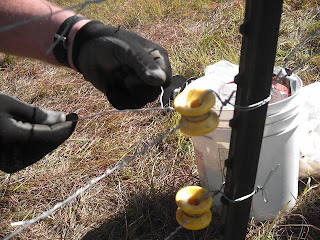 After all the corner posts are set and the steel fence posts and insulators are up it is time to put the wire through the insulators. We start at the corner post, a different type of insulator is used for corner posts and steel fence posts.
After all the corner posts are set and the steel fence posts and insulators are up it is time to put the wire through the insulators. We start at the corner post, a different type of insulator is used for corner posts and steel fence posts. Electric fence wire
Electric fence wire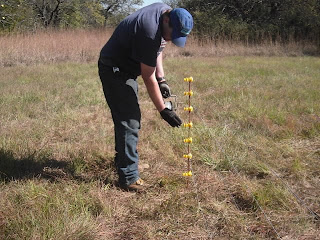 Running the wire through the insulators
Running the wire through the insulators After the wire is secured around the corner post insulator we go along the fence line and start running it through all the other insulators until we get to the end corner post where it pulled tight and tied off. A piece of electric fence wire can be wrapped and threaded vertically between each of the seven strands of fence to make them all hot. We put the two cattle panel gates in and we were done! The next step is to test the fence with an electric fence tester to make sure it is charging well and then it is time to let the goats out!
After the wire is secured around the corner post insulator we go along the fence line and start running it through all the other insulators until we get to the end corner post where it pulled tight and tied off. A piece of electric fence wire can be wrapped and threaded vertically between each of the seven strands of fence to make them all hot. We put the two cattle panel gates in and we were done! The next step is to test the fence with an electric fence tester to make sure it is charging well and then it is time to let the goats out! South side of finished fence
I was going to post some pictures of the goats in their new pasture but somebody...not naming names (my husband Jamey) dropped the camera and broke it, well accidents happen and at least that solves that little "what do I need for Christmas" problem! hehe



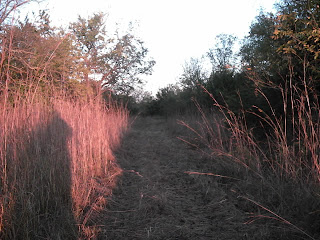


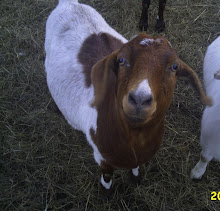







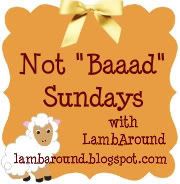
6 comments:
Nice pictures and aren't you glad that is out of the way!
Wow, that was quite a project. We have an electric fence for our goats, which gives me more peace of mind, mostly keeping stray dogs away, as we have problems with that occasionally! I loved your precious "goat of the week" picture in your last post...how sweet! I do enjoy your posts so much!
Juri
Thank you Amy! I am very glad that is out of the way!
Thank you Juri!
i wonder if this works for dogs too?
Thanks for the pics. My two cute and adorable Nigerian dwarf does have devastated my orchard now. No bark left. I live in a place where they just stare at you quizzically in the feed store when you ask about electric fencing and I don't know anyone who has put one up. I have been desperately looking for pictures of how to to get a good goat fence up. Sadly, it's too late for my apple trees, but I might still be able to save my other trees!
Hello,
Nice blog i like it thanks for this information
Post a Comment